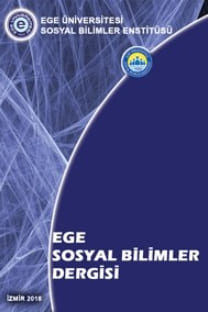Derslerde Teknoloji Kullanımına Yönelik Motivasyon Ölçeğinin Geliştirilmesi
Öğrenenin motivasyonu öğretim ortamında daha iyi ve kalıcı öğrenmenin gerçekleşmesi için en önemli parametrelerden biri olarak gösterilebilir. Öğrenenin motivasyonunun artırılması amacı ile farklı araç, gereçler, materyaller, öğretim yöntemleri, iletişim yöntemleri vb. unsurlar işe koşulmaktadır. Alanyazında yapılan araştırmalar, teknolojinin eğitim öğretim ortamlarında kullanımının motivasyonu artıran en önemli unsurlardan biri olduğunu göstermektedir. Bu nedenle son yıllarda bilgisayar, barkovizyon, tablet, akıllı tahta vb. birçok teknolojik araç gerecin sınıf ortamında kullanımı artmıştır. Bu çalışmada derslerde kullanılan teknolojilerin öğrencilerin motivasyonu üzerindeki etkisinin ölçülebilmesi için bir likert tipi ölçek geliştirilmesi amaçlanmıştır. Bu amaç doğrultusunda öncelikle alanyazın incelenerek bir madde havuzu oluşturulmuş, ardından bu maddeler uzmanların görüşüne sunulmuştur. Uzman görüşlerinden sonra elde edilen taslak form 208 üniversite öğrencisine uygulanmıştır. Yapılan açıklayıcı faktör analizi ile tek faktörlü 19 maddelik bir ölçek elde edilmiştir. Daha sonra bu yapı doğrulayıcı faktör analizi ile test edilerek doğrulanmıştır. Güvenirlik analizi sonucunda ölçeğin güvenilirlik katsayısı .95 hesaplanmıştır.
Anahtar Kelimeler:
Eğitim, Motivasyon, Teknoloji, Ölçek geliştirme
Developing Motivation Scale for Using Technology in Courses
The motivation of the learner can be shown as one of the most important parameters for better and permanant learning in the learning environment. Different tools, materials, teaching methods, communication methods etc. are used to increase the motivation of the learner. Research in the literature shows that the use of technology in educational environments is one of the most important factors that increase motivation. Therefore, in recent years, the use of many technological devices such as computers, barcovision, tablet, smart board etc. has increased in the classroom environment. In this study, it is aimed to develop a likert type scale in order to measure the effect of technologies used in courses on students' motivation. For this purpose, firstly, a literature pool was formed by examining the literature and then these items were presented to the experts' opinions. After receiving the opinions of experts, the experimental form was applied to 208 university students. With the explanatory factor analysis, a single factor 19-item scale was conducted. This structure was then tested and confirmed by confirmatory factor analysis. As a result of the reliability analysis, the reliability coefficient of the scale was calculated as .95.
Keywords:
Education, Motivation, Technology, Scale development,
___
- Altman, D.G. (1991). Practical statistics for medical research. London: Chapman and Hall.
- Arslan, A. (2006). Bilgisayar Destekli Eğitim Yapmaya İlişkin Tutum Ölçeği. Yüzüncü Yıl Üniversitesi, Eğitim Fakültesi Dergisi, 3(2), 24-33.
- Autio, O., Hietanoro, J., & Ruismäki, H. (2011). Taking part in technology education: Elements in students’ motivation. International Journal of Technology and Design Education, 21(3), 349-361.
- Blau, G., Gaffney, A., Schirmer, M. L., Ozkan, B., & Kim, Y. J. (2019). Exploring the Relationship of Background, Technology and Motivation Variables to Business School Transfer Intent for Two Mixed Course Format Business Undergraduate Samples. Online Learning, 23(1), 80-94.
- Büyüköztürk, Ş. (2006), Veri Analizi El Kitabı, 6. Baskı, Ankara: Pegem A Yayıncılık.
- Byrne, B. M. (1994). Structural equation modeling with EQS and EQS/Windows: Basic concepts, applications, and programming. Sage: Thousand Oaks, CA.
- Cullen, T. A., & Greene, B. A. (2011). Preservice Teachers’ Beliefs, Attitudes, and Motivation about Technology Integration. Journal of Educational Computing Research, 45(1), 29–47. https://doi.org/10.2190/EC.45.1.b
- Çubukçu, Z., & Tosuntaş, Ş. B. (2016). Teknoloji Destekli Eğitim Ortamlarında İletişim: Bir Sınıf Etkileşim Analizi Çalışması. Eğitim ve Öğretim Araştırmaları Dergisi, 5, 192-199.
- Gabrielle, D. (2003). The effects of technology-mediated instructional strategies on motivation, performance, and self-directed learning. In EdMedia+ Innovate Learning (pp. 2568-2575). Association for the Advancement of Computing in Education (AACE).
- George, D., & Mallery, P. (2011). SPSS for Windows step by step: A simple guide and reference. 11.0 update (4th ed.). Boston: Allyn & Bacon.
- Higgins, K., Huscroft-D’Angelo, J., & Crawford, L. (2019). Effects of technology in mathematics on achievement, motivation, and attitude: a meta-analysis. Journal of Educational Computing Research, 57(2), 283-319. https://doi.org/10.1177/0735633117748416
- Ilter, B. G. (2009). Effect of technology on motivation in EFL classrooms. Turkish online journal of distance education, 10(4), 136-158.
- Jeno, L. M., Adachi, P. J., Grytnes, J. A., Vandvik, V., & Deci, E. L. (2019). The effects of m‐learning on motivation, achievement and well‐being: A Self‐Determination Theory approach. British Journal of Educational Technology, 50(2), 669-683.
- Kelloway, E. K. (1998). Using LISREL for structural equation modeling: A researcher's guide. Thousand Oaks, CA, US: Sage Publications, Inc.Kline, R. B. (2011). Principles and Practice of Structural Equation Modeling (3rd Edition). New York: The Guilford Press.
- Landis, J. & Koch, G. (1977). “The measurement of observer agreement for categorical data”. Biometrics, 33, 159–74.
- Olsen, A. K., & Chernobilsky, E. (2016). The effects of technology on academic motivation and achievement in a middle school mathematics classroom.
- Rau, P. L. P., Gao, Q., & Wu, L. M. (2008). Using mobile communication technology in high school education: Motivation, pressure, and learning performance. Computers & Education, 50(1), 1-22.
- Schermelleh-Engel, K., & Moosbrugger, H. (2003). Evaluating the fit of structural equation models: Test of significance and descriptive goodness-of-fit measures. Methods of Psychological Research Online, 8(2), 23-74.
- Şencan, H., (2005) Sosyal ve Davranışsal Ölçümlerde Güvenilirlik ve Geçerlilik, ISBN: 975-347-884-4. Ankara.
- Tabachnick, B. G., Fidell, L. S., & Ullman, J. B. (2007). Using multivariate statistics (Vol. 5). Boston, MA: Pearson.
- Taşdemir, S. (2013). Motivasyon Kavramına Genel Bir Bakış, Motivasyon Araçları ve Bilgi Teknolojileri ve İletişim Kurumu Ölçeğinde Bir Model Önerisi. Ankara: Bilgi Teknolojileri ve İletişim Kurumu
- Torgerson, W. S. (1958) Theory and Methods of Scaling. New York: JohnWiley & Sons, Inc.
- Yayın Aralığı: Yıllık
- Başlangıç: 2018
- Yayıncı: Ege Üniversitesi
Sayıdaki Diğer Makaleler
ERZURUM ÇOCUK FOLKLORU VE EDEBİYAT
Kurumsal Alanın Gerektirdiği Çevirmen Modeli
Sevcan SEÇKİN, Emine Bogenç Demirel
Çeşme Yarımadası’nda Kıyının Kamusal Kullanımına Etki Eden Kıyı Kullanımlarına Eleştirel Bir Bakış
İsmail Oğuz ATAKAN, Ahu DALGAKIRAN ERDOĞAN
Derslerde Teknoloji Kullanımına Yönelik Motivasyon Ölçeğinin Geliştirilmesi
Metin KARADAĞ, Ali Erhan ZALLUHOĞLU, Gülçin Gürel GÜNAL, Oktay DAYIOĞLU, Tarık KIŞLA
